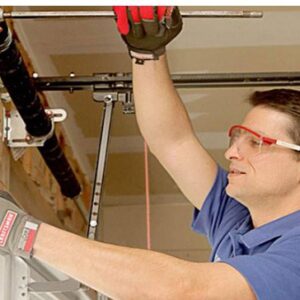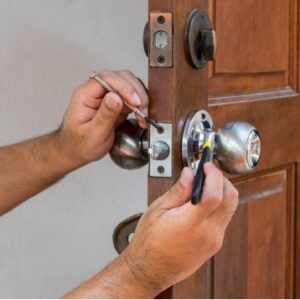A garage door operates on a system of tension and balance. When one part wears out, the entire system begins to struggle. Two of the most critical components that keep the door moving smoothly are the cables and rollers. Over time, both experience wear from constant use, temperature changes, and exposure to dirt or moisture. Understanding how these parts work and when to replace them helps prevent unexpected breakdowns and keeps your door running safely and quietly.
The Role of Cables and Rollers in Garage Door Movement
Cables lift and lower the door by carrying the full weight of the panels. They are wound around drums connected to the torsion springs, which store and release tension during operation. When a cable frays or loses tension, the door may become uneven, shake while moving, or stop mid-way.
Rollers guide the door along the tracks, helping it move smoothly. Worn or damaged rollers create grinding noises, jerky movement, and uneven wear on the tracks. Replacing damaged rollers not only restores smooth operation but also reduces strain on the motor and other components.
When both cables and rollers work together correctly, your garage door moves quietly and maintains balance, reducing the risk of sudden failures.
Common Signs of Cable and Roller Wear
We can often tell when the cables or rollers start to fail by paying attention to how the door behaves. One of the earliest signs is noise. Grinding, squeaking, or rattling sounds usually point to metal rollers or cables rubbing against other parts. Another clue is uneven door movement, where one side moves faster or slower than the other. This imbalance can cause the door to jam or tilt.
Frayed or rusted cables are an immediate concern. A single broken strand may seem harmless, but once the cable weakens, it can snap suddenly under tension. This can cause the door to drop unexpectedly, creating a serious safety hazard.
Damaged rollers are just as easy to identify. They often show cracks, flat spots, or wobble in their brackets. Plastic rollers tend to wear faster, especially in cold weather, while steel rollers may rust without regular lubrication.
Why Cable and Roller Replacement Matters
Ignoring early signs of wear only leads to more expensive problems. Cables that fail completely can damage tracks, springs, and the opener. Similarly, worn rollers can bend tracks or cause the opener to overheat. Replacing these parts before they break avoids costly repairs and extends the life of your entire door system.
Smooth rollers also reduce energy loss and noise. When the door glides easily, the opener does not work as hard, which means lower power consumption and less stress on the motor. A properly balanced door supported by fresh cables and rollers also protects the torsion springs, preventing premature breakage.
If you notice any of these symptoms, it is best to schedule professional service from a company experienced in garage door repair in Calgary. Timely maintenance ensures that every part of the system stays in balance and continues working efficiently.
How Professionals Replace Garage Door Cables
Replacing cables requires precision and safety knowledge. Cables are tightly wound under spring tension, so even a small mistake can cause serious injury. Professionals begin by safely releasing spring tension and disconnecting the cables from the drum. They then inspect the drum, bearings, and torsion shaft for damage before fitting the new cables in place.
Quality cables are made of multi-strand steel wire that resists fraying and corrosion. Once installed, the technician rewinds the tension, checks the door balance, and tests the movement several times. The goal is to ensure even lifting on both sides and smooth operation without slack or strain.
DIY replacement often goes wrong because the process involves handling heavy tensioned parts. While lubricating or cleaning cables is safe to do yourself, actual replacement should always be handled by trained professionals who understand the spring system and safety protocols.
The Importance of Using Quality Rollers
Not all rollers are the same. The type of roller you choose directly affects performance and noise. Steel rollers are durable and ideal for heavy doors but can be noisy without proper lubrication. Nylon rollers are quieter and provide smoother movement, though they tend to wear faster under extreme cold or heavy loads.
A professional technician selects rollers based on the weight of your door, the type of tracks, and the level of noise you want to reduce. During installation, they check the alignment of each roller and the straightness of the track. Misaligned rollers cause scraping and can pull the door out of balance.
Replacing all rollers at once ensures consistent performance and prevents the old ones from wearing out faster under uneven pressure. After replacement, lubrication helps maintain smooth movement and prevents squeaking.
Lubrication and Maintenance Tips for Longer Life
After cable and roller replacement, regular maintenance is essential to keep the system working properly. Light lubrication every few months keeps friction low and protects moving parts from rust. Use a silicone-based lubricant or garage door spray designed for metal components. Avoid thick grease, which attracts dust and dirt.
Inspect the cables visually every few months. Look for frayed strands, rust, or uneven tension between the two sides. For rollers, check for cracks or flat edges. If you hear clicking or grinding when the door moves, stop operating it and call a professional before further damage occurs.
A good rule is to schedule a full inspection once a year. This allows small issues to be addressed before they grow into major problems.
Balancing the Door After Replacement
Replacing cables or rollers can affect door balance. A properly balanced door stays in place when you lift it halfway and let go. If it moves up or down on its own, the tension in the springs may be off. Professionals test and adjust the balance after every repair to ensure the opener does not overwork itself.
An unbalanced door wears down the motor faster and can cause cables to slip or unwind unevenly. Over time, this imbalance may lead to track bending or spring failure.
Safety Precautions Homeowners Should Know
Garage door cables are under high tension, and a sudden snap can cause serious injury. If a cable breaks, avoid touching or trying to reset it. Do not use the opener or attempt to open the door manually. Instead, secure the area and wait for a technician to assess it.
Similarly, when a roller comes off the track, forcing the door closed or open can bend the tracks or damage the panels. Always disconnect the opener power and keep the door stationary until it is repaired.
Simple habits like keeping the tracks clean, avoiding excess force, and scheduling routine maintenance prevent most accidents.
The Connection Between Cables, Rollers, and Door Springs
Cables and springs work together as part of the lifting system. The springs hold the tension, while the cables transfer it to raise and lower the door. If one part fails, it affects the other. Weak cables cause uneven spring tension, and weak springs make cables work harder, increasing wear.
Rollers help guide this entire motion, ensuring the force from the springs and cables stays evenly distributed. That is why replacing one without checking the others is rarely effective. A technician often inspects all connected parts before finishing the repair.
Understanding this connection helps homeowners appreciate why small issues should not be ignored. Regular inspections prevent the domino effect that starts with one faulty part and ends with a total system failure.
When to Replace Instead of Repair
Sometimes replacement is a better choice than temporary repair. Cables that show visible fraying, rust, or unraveling are not safe to patch or twist back together. Similarly, if more than half your rollers are cracked or bent, replacing the entire set is more effective and safer than fixing one or two.
Doors over ten years old that have never had major maintenance usually benefit from a full hardware replacement. This includes rollers, cables, hinges, and sometimes tracks. The investment pays off in smoother operation, less noise, and fewer emergency calls.
Professional Service vs DIY
While many homeowners enjoy handling small repairs, garage door systems are not ideal for experimentation. The tension in the springs and cables makes them hazardous without the right tools and experience. Professional technicians not only replace parts safely but also check for hidden wear that could cause future issues.
DIY attempts often miss misalignment or imbalanced tension, leading to repeat breakdowns. Professionals adjust all related components together to restore long-term stability. This saves money and time by preventing repeated service calls.
If you suspect any issue with your cables or rollers, it is best to reach out and contact us for an inspection or repair appointment.
Added Insight: Seasonal Effects on Garage Door Components
In Calgary, the wide temperature swings between winter and summer affect metal components significantly. Cold temperatures cause metal cables and rollers to contract, increasing friction and stiffness. As a result, many homeowners notice their doors becoming noisy or sluggish during winter.
A simple preventive step is applying lubricant before the first cold snap. Silicone spray resists freezing and keeps parts flexible. In summer, cleaning off old grease and reapplying fresh lubricant prevents dust buildup that slows the rollers.
Keeping an eye on these seasonal changes helps maintain smooth motion and prevents small issues from becoming expensive replacements.
FAQs
- How long do garage door cables and rollers usually last?
Cables typically last around seven to ten years, depending on use and weather exposure. Rollers may last five to seven years, but nylon rollers usually need earlier replacement in colder climates. - Can I replace cables or rollers myself?
It is not recommended. The system is under high tension and can cause injury if handled incorrectly. Professional technicians have the right tools and safety training to do the job safely. - Why does my garage door make loud popping or scraping noises?
This usually happens when rollers are worn or tracks are misaligned. The sound means metal parts are rubbing where they should glide. A quick inspection can reveal if rollers or cables need attention. - How can I tell if my garage door is unbalanced?
Disconnect the opener and lift the door halfway. If it moves up or down instead of staying still, the tension is off and needs professional adjustment. - How often should I schedule maintenance?
Once a year is enough for most homes. However, if the door is used more than five times daily, or you live in an area with harsh weather, consider two inspections per year.




